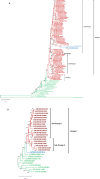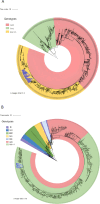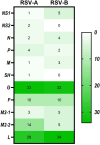Genomic characterization of circulating human respiratory syncytial viruses A and B in Kuwait using whole-genome sequencing
- PMID: 38808977
- PMCID: PMC11218466
- DOI: 10.1128/spectrum.00159-24
Genomic characterization of circulating human respiratory syncytial viruses A and B in Kuwait using whole-genome sequencing
Abstract
The human respiratory syncytial virus (RSV) is considered one of the most common viruses that infect children globally. The virus is known to have extensive gene sequence variability within and between RSV groups A and B globally; however, there is no information on the whole-genome characterization and diversity of RSV in Kuwait. Therefore, this study aimed to sequence the entire genome of RSV strains isolated from patients with acute respiratory tract infection (ARTI) in Kuwait. Therefore, this study aimed to sequence the entire genome of RSV strains isolated from patients with ARTI in Kuwait. Between January 2020 and September 2022, 7,093 respiratory samples were collected from hospitalized infants, children, and adults and were analyzed for respiratory viruses by multiplex real-time PCR. Whole-genome sequencing using the Oxford Nanopore sequencing technology was performed on 84 RSV-positive samples. The results revealed a higher prevalence of group A (76%) than group B (24%) RSV isolates. Phylogenetic analysis showed that RSV-A strains clustered with the GA2.3.5 sub-genotype and RSV-B strains clustered with the GB5.0.5a sub-genotype; however, forming new lineages of RSV-A and RSV-B circulated in Kuwait during this period. Genetic variability was higher among the group A viruses than group B viruses, and the rate of synonymous and missense mutations was high in genes other than the G protein-coding gene. We also detected several known and unique molecular markers in different protein-coding genes. This is the first study in Kuwait to characterize the whole genomes of RSV A and B to identify the circulating genotypes, comprehend the genetic diversity and the evolution of the virus, and identify important genetic markers associated with specific genotypes.IMPORTANCEWhole-genome sequencing of respiratory syncytial virus (RSV) strains in Kuwait using MinION Nanopore technology was used to characterize and analyze the genotypes and sub-genotypes of the RSV circulating among patients with acute respiratory tract infections in Kuwait. This study also identified known and unknown gene mutations and imported genetic markers associated with specific genotypes. These results will assist in establishing a framework for RSV classification and allow for a better consideration of the mechanisms leading to the generation of diversity of RSV. In addition, these data will allow a comparison of vaccine viruses with those in Kuwait, providing useful insights into future vaccine and therapy strategies for RSV in Kuwait.
Keywords: Kuwait; nanopore sequencing; respiratory syncytial virus; whole-genome sequencing.
Conflict of interest statement
The authors declare no conflict of interest.
Figures








References
-
- Nair H, Brooks WA, Katz M, Roca A, Berkley JA, Madhi SA, Simmerman JM, Gordon A, Sato M, Howie S, et al. . 2011. Global burden of respiratory infections due to seasonal influenza in young children: a systematic review and meta-analysis. Lancet 378:1917–1930. doi:10.1016/S0140-6736(11)61051-9 - DOI - PubMed
MeSH terms
Grants and funding
LinkOut - more resources
Full Text Sources
Medical

